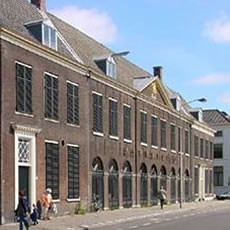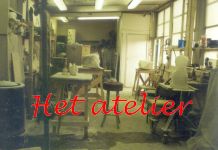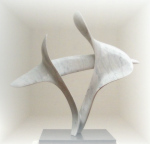|
Esthetics
as a passion
Mark Rietmeijer is
as a teacher "sculpting in stone" attached to the Koorenhuis.
With a member of the editorial staff he had a  conversation
about his motives and way of teaching. conversation
about his motives and way of teaching.
How did you come
to be a sculptor?
After a study in road-
and hydraulic engineering, in the early 70's I was employed by
building companies, architects and the offshore. But that turned
out not to be my cup of tea. I wondered what I did want to do.
As a child I was always busy with pottering, drawing, making things
in clay and the like. So I came to making sculptures. In '76 I
could rent a studio, where I began.
Do I gather you
are self-taught?
Yes, that's right.
Academies, well, they seemed not the right step for me to make,
too busy. As soon as I had my own studio I went on like mad making
sculptures, a kind of humanlike figures, mostly as a therapy.
Then for two more years I made torsos from model and after that
I searched abstraction. Recalling Brancusi I say: "Do not
copy the bird but his ability to fly." Much more dynamic!
Did you always
work in marble?
I started working
in clay, plaster and wax. I learned how to make moulds and how
to cast in concrete, aluminiumcement and granito. Not until '82
I started carving in stone. In the garden of my studio I found
a piece of stone I thought to be marble. Later on that even turned
out to be statuario (a very crystalline, unveined sort of Italian
marble). It had been buried there by a local  sculptor,
named Georg Graff, who had build the four studio's of which I
rented one. Then I bought tools and started carving. I had always
had the idea that such was very difficult, but after a couple
of days I realized I could do it. After that very first experience
Ibecame devoted...! sculptor,
named Georg Graff, who had build the four studio's of which I
rented one. Then I bought tools and started carving. I had always
had the idea that such was very difficult, but after a couple
of days I realized I could do it. After that very first experience
Ibecame devoted...!
Where do you find
marble for the courses?
Strictly spoken marble
is not stone at al. The base material is the external skeleton
of marine animals, which deposited between 200 millions and 10
millions of years ago as chalk on the bottom of the seas. After
they ran dry, the chalk sediments became metamorphosed to marble
by coverage of other earth layers under high pressure and temperature.
For the courses we use marble roller stones, that are picked up
from the riverbeds in the vicinity of Carrara. To the course-members
I use to say: now your stone is still rough, but when you grind
and polish your form the veins do show up, which you may consider
as a present for your hard labor.
Does carving in
stone need much physical strength?
No, for many women
visit the courses and they show that carving in stone has nothing
to do with physical strength. Whether you can do it or not is
a matter of mentality. You must be able to make contact with the
stone.
What line do you
take in courses?
Previously I forbid
the members to start from a concept, a model, a plan or a strategy.
This method is called: "taille-directe". Literally that
means: "direct-carving". Nowadays, due to the excessive
confrontation with images, people have a lot of formal idioms
at their disposal. That is why I tell the members: "forget
everything, just carve an interesting dent in the stone and see
what happens." What do you see? You split up the amorphous
mass, you create two or three separate volumes which you try to
link together again in an exciting way. Thus something comes into
being that looks like form. It is a kind of action/reaction-synthesis,
splendidly phrased by Heidegger: "carving in stone is like
clearing-out and arranging a room in one and the same act."
And I slow that down to: "at first you clear away, then you
define what is left, and subsequently arrange that." In general
the members are all on wires. They soon have got the hang of it.
Yet before we start I ask them to clay in the blind. I turn off
the lights and give them something to cover their eyes. The aim
is feeling with your hands. Afterwards I let them guess and up
till now everyone knows exactly to point out her or his own form.
Do you push the
course-members to work abstract?
In a sense working
abstract is easier. Previous experience in plastic materials is
needed to carve a torso or a portrait in stone directly. Most
of the time I advise the members: when it tends to look like anything
in the outside world, put it upward down and start again.
How do you experience
teaching?
I think teaching to
be very instructive to myself and very nice to do. In due course,
when the sculptures gain form, to me it is a simultaneous effort
to accompany all sorts of forms and ideas.
Is there much interest
in your courses?
In 1990 I started
one course and now there are five, three of which in solid stone
(Italian and Portuguese marble, Belgian and Irish blackstone and
whatever stone the advanced members meet on their trips throughout
Europe) and two courses in soft stone (soapstone, alabaster, French
limestone, serpentine, springstone etc.). In various courses there
is a 'core' of members who have been sculpting for years already.
And how about the
interest in your own work?
 My sculptures are very expensive, for blocks of marble are high-priced.
Meanwhile making a sculpture takes me more than a year, but every
two or three years I do sell one. Carving in stone has disappeared
from the international mainstream. In galleries contemporary sculptures
in stone are rarely to be seen. Likewise there are no more than
three professional stone-cutters in The Hague at the moment, while
on the other hand public gusto towards sculpting in stone is evident.
My work is considered as traditional. I go for beauty, esthetics
is my passion.
My sculptures are very expensive, for blocks of marble are high-priced.
Meanwhile making a sculpture takes me more than a year, but every
two or three years I do sell one. Carving in stone has disappeared
from the international mainstream. In galleries contemporary sculptures
in stone are rarely to be seen. Likewise there are no more than
three professional stone-cutters in The Hague at the moment, while
on the other hand public gusto towards sculpting in stone is evident.
My work is considered as traditional. I go for beauty, esthetics
is my passion.
|